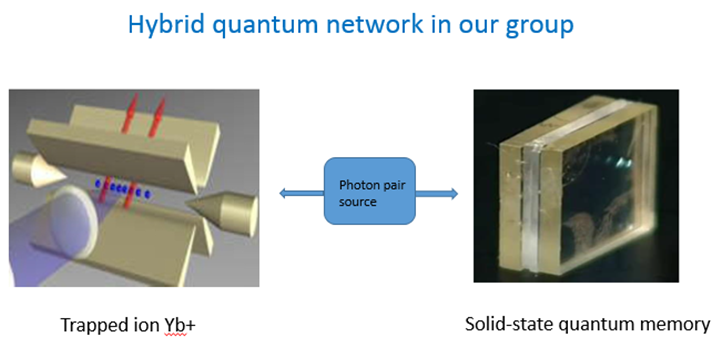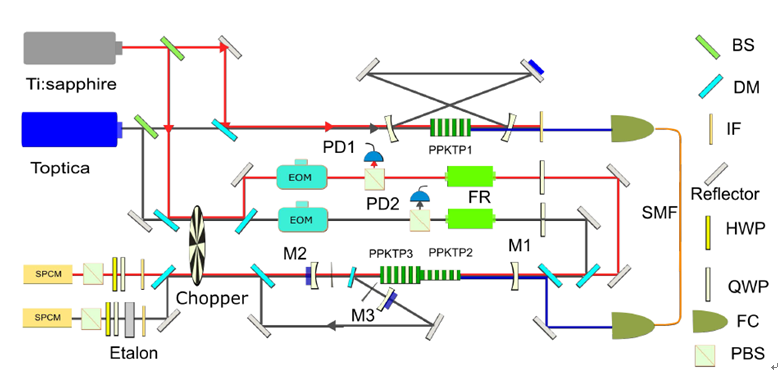The realization of quantum networks composed of quantum nodes and quantum channels is of great importance to the distributed quantum computation and quantum communication. The function of the quantum node is the operation and storage of the quantum state, and the function of the quantum channel is the distribution of quantum information [1]. Shown in Fig.1.
![Fig.1. [Image: Scheme for quantum network by kimble]](./images/research/kimble.PNG)
Fig.1.
Much experimental progress has been achieved in this aspect for different physical systems, such as atomic ensembles, single atoms and trapped ions [2,3,4]. In comparison, hybrid quantum networks consisting of various physical systems [5] can combine the different advantages of diverse physical systems. In our group, we try to build a hybrid quantum network combined with trapped ion and rare-earth doped solid state quantum memory. Shown in Fig.2.

Fig.2.
For the computing nodes, trapped ions can be a suitable candidate because they are one of the most promising physical systems for the realization of quantum computation and simulation [6, 7]. For the storing nodes, a promising candidate is the rare-earth ion-doped crystal system, because it has already shown excellent merits in regard to quantum memory [8,9,10]
However, photonic interface compatible with the physical systems in hybrid quantum network are not identical. Considering the functions and aims, there are some requirements to get a well-fitted photonic interface. The central frequency and bandwidth of the photons should be matched perfectly with the physical systems in hybrid quantum network.Last but not least, entanglement should be existed in this progress. To satisfy the requirements, generation of nondegenerate narrow-band entangled photon pairs will be a good proposal to reach the goal.

Fig.3.
As shown in Fig.3. We came up with a newly-designed conjoined double-cavity structure to generate the nondegenerate entangled narrow-band photon pairs firstly in experiment. By tomography, we get a source with fidelity of xx%.
- [1] H. J. Kimble, The quantum internet, Nature (London)453, 1023 (2008).
- [2] N. Sangouard, et al, Rev. Mod. Phys. 83, 33 (2011).
- [3] S. Ritter, et al, An elementary quantum network of single atomsin optical cavities, Nature (London) 484, 195 (2012).
- [4] L.-M. Duan and C. Monroe, Quantum networks withtrapped ions, Rev. Mod. Phys. 82, 1209 (2010).
- [5] M. Wallquist, et al, Hybrid quantum devices and quantum engineering,Phys. Scr. T137, 014001 (2009).
- [6] R. Blatt, D. Wineland, Entangled states of trappedatomic ions, Nature (London) 453, 1008 (2008).
- [7] J.-M. Cui, et al, Supporting Kibble-Zurek Mechanismin Quantum Ising Model through a Trapped Ion, arXiv:1505. 05734.
- [8] Z.-Q. Zhou, et al, Realization of Reliable Solid-State Quantum Memoryfor Photonic Polarization Qubit, Phys. Rev. Lett.108, 190505 (2012).
- [9] Z.-Q. Zhou, et al, Quantum Storage of Three-Dimensional Orbital-Angular-Momentum Entanglementin a Crystal, Phys. Rev. Lett. 115, 070502 (2015).
- [10] Jian-Shun Tang, et al, Nature communications 6, 8652